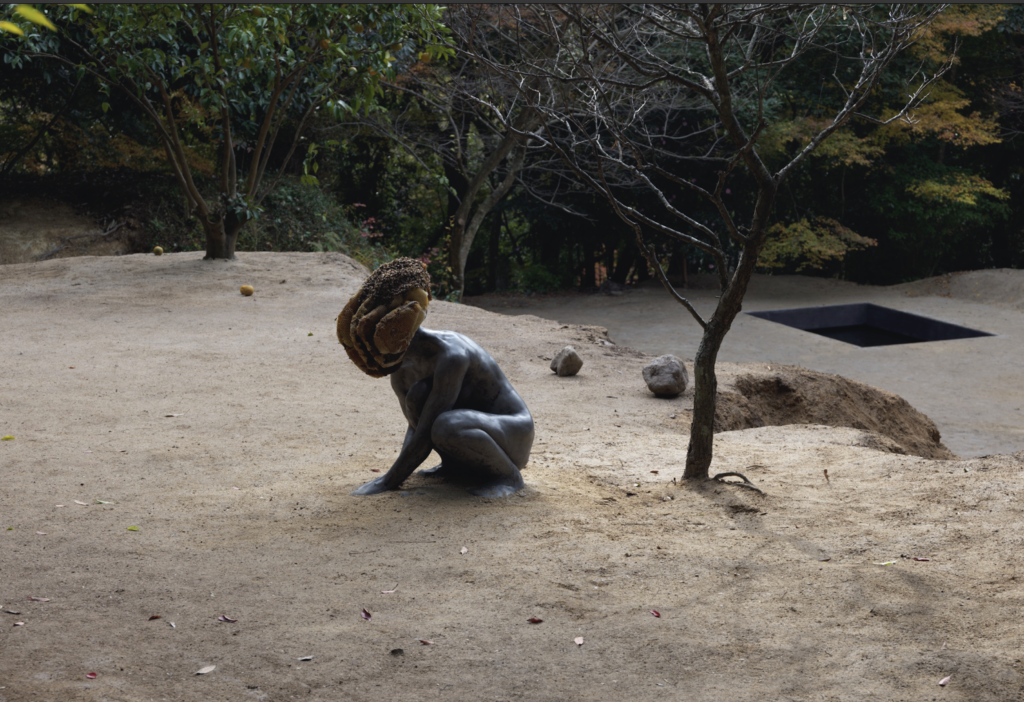
For the second edition of the MICAS international programme, French artist Pierre Huyghe presents his work Exomind (Deep Water) as an ongoing ‘self-organising system’ where Nature is a key participant in the art. A crouching female figure cast in grey raw concrete whose hands are touching the earth has a live growing beehive mounted in place of the head. This conceptual rendering combines several different and contrasting elements together to probe questions on ‘intelligence’. On the one hand, the statuette is a product of human culture, whilst the hive is the production of Nature. Furthermore, the bees thrive on pollinating the flora and surrounding vegetation which in turn depend on germination. The artist selected Wied il-Luq in Buskett, a site rich in indigenous garigue and biodiversity, including other creatures such as ants, bee-eaters, hornets and robbing bees. Within this setting, the work echoes life’s complexity reminiscing a diversity of co-existing, frictional or inter-dependent ‘eco-systems’ evolving inextricable planes of intellectual entanglement.
It is central to the creative process and the artist’s concept that the work is placed in a somewhat remote area rather than in a gallery or museum setting. In tandem with the work’s environmental connotations are the cultural systems within which art is produced. The outdoor setting for the installation presents certain curatorial challenges whilst having prompted exciting forms of curatorial collaboration with specialist beekeepers.
Exomind (Deep Water) is a powerful statement in the light of current-day concerns relating to the Anthropocene and Human Epoch. This central question concerns the human impact on Nature over the last 12,000 to 15,000 years. The juxtaposition of human versus other self-organising systems (such as the beehive) also poses other contentions and intellectual debate pertaining to the extent of advancing technologies and artificial intelligence. These issues are relevant not only within the Maltese context but within a worldwide situation considering the important ongoing disputes on global warming, escalating pollution levels, and the extinction of bees (apart from numerous other species) which would also endanger human existence on the planet. The importance of bees to our food supply goes without question, as without them our gardens would be bare and out plates empty.
This work is an edition of 10 and has been presented in other countries, most recently in Japan, sometimes as part of a more complex installation comprising other living organisms, objects or animals.
This work is important in the Maltese context as it draws together various levels of contemporary thinking and pushes several boundaries. The enculturation processes in familiarising, educating and engaging the Maltese public with challenging works of art are a primary role for MICAS as the leading platform for contemporary art in Malta. Above all, placed in the Buskett woodland, Exomind (Deep Water) becomes accessible to families and children and a broad spectrum of the public seeing that it merges the humanities and the sciences intrinsically.
Exomind (Deep Water) is open for public viewing until the 31st of January 2020.
Share

Operational Programme I – European Structural and Investment Funds 2014-2020 “Fostering a competitive and sustainable economy to meet our challenges”. Project may be part-financed by the European Regional Development Fund Co-financing rate: 80% European Union Funds; 20% National Funds.


Operational Programme I – European Structural and Investment Funds 2014-2020 “Fostering a competitive and sustainable economy to meet our challenges”. Project may be part-financed by the European Regional Development Fund Co-financing rate: 80% European Union Funds; 20% National Funds.

© Malta International Contemporary Art Space 2023
© Malta International Contemporary Art Space 2023
© Malta International Contemporary Art Space 2024






Operational Programme I – European Structural and Investment Funds 2014-2020 “Fostering a competitive and sustainable economy to meet our challenges”. Project may be part-financed by the European Regional Development Fund Co-financing rate: 80% European Union Funds; 20% National Funds.


Operational Programme I – European Structural and Investment Funds 2014-2020 “Fostering a competitive and sustainable economy to meet our challenges”. Project may be part-financed by the European Regional Development Fund Co-financing rate: 80% European Union Funds; 20% National Funds.

© Malta International Contemporary Art Space 2023
© Malta International Contemporary Art Space 2024
© Malta International Contemporary Art Space 2024